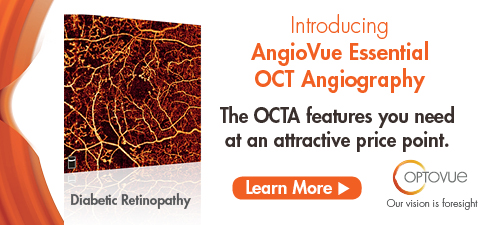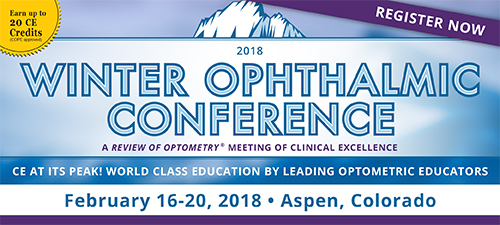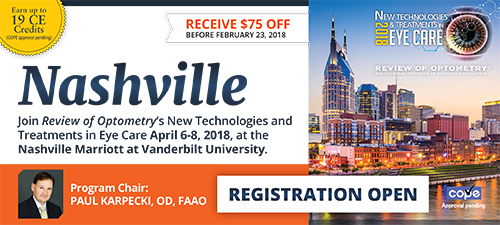
A
weekly e-journal by Art Epstein, OD, FAAO
Off the Cuff: A Path Forward
While good news has been increasingly sparse in health care and especially in optometry, this week I am excited to share what I believe will be one of the most important advances in our profession in decades. COPE (Council on Optometric Practitioner Education) CE accreditation has been deemed “substantially equivalent” to the ACCME (Accreditation Council for Continuing Medical Education) CME accreditation system. This equivalence creates a path forward for optometry to become a substantial and accepted part of a larger healthcare system that has, in the past, typically shunned us.
|
|||||
|
|||
| The Berkeley Dry Eye Flow Chart: A Fast, Functional Screening Instrument for Contact Lens-induced Dryness | ||||
In this article, researchers introduced a novel, flow chart-based screening tool for the categorization of contact lens-induced dryness (CLIDE) and its impact on daily visual activities: the Berkeley Dry Eye Flow Chart (DEFC). One hundred thirty experienced soft contact lens wearers discontinued lens wear for 24 hours, passed a baseline screening and eye health examination, completed the Ocular Surface Disease Index (OSDI) then were dispensed fresh pairs of their habitual lenses. After six hours of wear, subjects were administered a battery of symptom questionnaires and underwent non-invasive tear breakup time (NITBUT) measurements, grading of distortion in reflected topographer mires, grading of lens surface wettability and a fluorescein examination of the ocular surface. Subjects returned after at least 48 hours and repeated all assessments after six hours of wear of a second fresh pair of habitual lenses. The repeatability of the DEFC between visits was within 1%, and limits of agreement and coefficient of repeatability were comparable to those of the other CLIDE assessments. Higher DEFC scores were significantly related to shorter pre-lens NITBUT, higher OSDI scores and higher visual analog scale (VAS) ratings of average and end-of-day severity, and frequency of dryness. For CLIDE, as diagnosed based on DEFC score, the highest sensitivities and specificities were achieved by the OSDI and VAS ratings; pre-lens NITBUT exhibited good sensitivity but poor specificity. The optimum pre-lens NITBUT diagnostic threshold was found to be ≤ 2.0 sec for debilitating CLIDE, and the OSDI threshold was ≥ 11.4. The DEFC provided a means of quickly categorizing CLIDE patients based on severity and frequency of symptoms, and on the degree to which symptoms impact daily life. Researchers concluded that the DEFC had several potential advantages as a CLIDE screening and monitoring tool, had good repeatability and was significantly related to commonly employed clinical assessments for CLIDE. |
||||
SOURCE: Graham AD, Lundgrin EL, Lin MC. The Berkeley dry eye flow chart: A fast, functional screening instrument for contact lens-induced dryness. PLoS One. 2018;13(1):e0190752. |
||||
|
|||
| Genetic Risk Score is Associated with Vertical Cup-to-Disc Ratio and Improves Prediction of Primary Open-Angle Glaucoma in Latinos | ||||
Genome-wide association studies have identified multiple genetic variants associated with vertical cup-to-disc ratio (VCDR). Genetic risk scores (GRS) examine the aggregate genetic effect of individual variants on a trait by combining these separate genetic variants into a single measure. The purpose of this study was to construct GRS for VCDR, determine whether the GRS were associated with VCDR and whether GRS increased the discriminatory ability for primary open-angle glaucoma (POAG) in a Latino population. A total of 4,018 Latino participants were recruited from Los Angeles. Weighted and unweighted GRS were constructed using 68 previously reported VCDR single nucleotide polymorphisms (SNPs), as well as SNPs from researchers’ genome-wide association data. Linear and logistic regression analyses examined the associations of GRS with VCDR and POAG, respectively. To evaluate the discriminatory ability of the GRS for POAG, researchers conducted receiver operating characteristic (ROC) analyses.
The GRS were associated significantly with VCDR, after adjusting for age, gender, central corneal thickness, intraocular pressure and education. The weighted GRS explained an additional 2.74% of the variation in VCDR. Adding the weighted GRS derived from previously reported SNPs resulted in a moderate improvement in the discriminatory ability for POAG during ROC analyses, yielding an area under the ROC curve (AUC) of 0.735 (95% CI, 0.701 to 0.768). When researchers’ own SNPs were used, the AUC increased significantly to 0.809 (95% CI, 0.781 to 0.837). They obtained similar results for the unweighted GRS. Researchers identified a novel association between GRS and VCDR and noted GRS’ improvement in the discriminatory ability of POAG in a Latino population. |
||||
SOURCE: Nannini DR, Kim H, Fan F, et al. Genetic risk score is associated with vertical cup-to-disc ratio and improves prediction of Primary Open-Angle Glaucoma in Latinos. Ophthalmology. 2018; Jan 17. [Epub ahead of print]. |
||||
 |
||
| Elemental Composition at Silicone Hydrogel Contact Lens Surfaces | ||||
The outermost surface composition of 11 silicone hydrogel (SiHy) lenses was measured using X-ray photoelectron spectroscopy (XPS) to understand differences in wettability and potential interactions within an ocular environment. The SiHy lenses tested included balafilcon A, lotrafilcon A, lotrafilcon B, senofilcon A, comfilcon A and somofilcon A reusable two-week or monthly replacement lenses and delefilcon A, samfilcon A, narafilcon A, stenfilcon A and somofilcon A daily disposable lenses. All lenses were soaked for 24 hours in phosphate-buffered saline to remove all packaging solution and dried under vacuum overnight before analysis. X-ray photoelectron spectroscopy measurements were performed at two take-off angles—55 degrees and 75 degrees, to evaluate changes in elemental composition as a function of depth from the surface.
Detailed analyses of the XPS data revealed distinct differences in the chemical makeup of the different lens types. For all lenses, carbon, oxygen and nitrogen were observed in varying quantities. In addition, fluorine was detected at the outermost surface region of comfilcon A (3.4%), and lotrafilcon A and B (<0.5%). The silicon content of the near-surface region analyzed varied among lens types, ranging from a low of 1.6% (lotrafilcon B) to a high of 16.5% (comfilcon A). In most instances, silicon enrichment at the outermost surface was observed, resulting from differences in lens formulation and design. Lenses differed most in their surface silicon concentration, with lotrafilcon B and delefilcon A exhibiting the lowest silicon contents and comfilcon A lens exhibiting the highest. Silicon has hydrophobic properties, which, when found at the surface, may influence the wettability of the contact lenses and their interaction with the tear film and ocular tissues. Investigators wrote that higher surface silicon contents have been previously correlated with adverse effects, such as enhanced lipid uptake, thus underscoring the importance of monitoring their presence. |
||||
SOURCE: Rex J, Knowles T, Zhao X, et al. Elemental composition at silicone hydrogel contact lens surfaces. Eye Contact Lens. 2018 Jan 15. [Epub ahead of print] |
||||
| News & Notes | ||||||||
| Johnson & Johnson Vision Expands Parameter Offering for 1-Day Acuvue Moist CLs for Astigmatism Johnson & Johnson Vision announced the U.S. launch of expanded parameters for 1-Day Acuvue Moist contact lenses for astigmatism, a daily disposable contact lens that offers patients the proprietary blink-stabilized Design for clear, stable vision and Lacreon technology providing a cushion of moisture for long-lasting comfort. With the addition of 48% more lens parameters for patients with astigmatism, the contact lens family now offers coverage for nearly 96% of spherical and astigmatic eyes. Read more. |
||||||||
SynergEyes Partners with Tangible Science
|
||||||||
|
||||||||
|
||||||||
|
||||||||
|
||||||||
|
Optometric Physician™ (OP) newsletter is owned and published by Dr. Arthur Epstein. It is distributed by the Review Group, a Division of Jobson Medical Information LLC (JMI), 11 Campus Boulevard, Newtown Square, PA 19073. HOW TO ADVERTISE |





